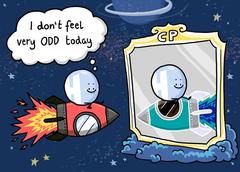A schematic illustration of the Higgs boson in a CP-mirror: While the color and the direction of the rocket change in the mirror (representing the change in the charge C and parity P symmetries), the Higgs boson looks the same (as expected for CP-even) (picture: DESY/Designdoppel).
The CMS experiment at the LHC has measured another important property of the Higgs particle, its CP nature in the coupling to tau leptons. The collaboration presented the results this week at the online conference ICHEP2020, the most important conference in the field with almost 3000 registered participants worldwide. Scientists from DESY were heavily engaged in this measurement, which further supports the assumption that the Higgs field/particle is consistent with the description by the standard model of particle physics.
In 2012 the ATLAS and CMS collaborations discovered a boson with a mass of 125 GeV, i.e. approximately 125 times the mass of the proton, in proton-proton collisions at the CERN LHC. This has marked a milestone in high energy physics, as this particle has all the characteristics of the pivotal Higgs boson predicted more than 50 years ago. However, many mysteries in the Universe remain unsolved, like the abundant presence of dark matter, the fact that the neutrino mass cannot be explained within the framework of the theory of Peter Higgs and colleagues, and many others. These unsolved problems anticipate the existence of other elusive particles. One possibility to search for hints and traces of new particles is via studies of deviations of the features of the Higgs boson from their expected values. Therefore, since the discovery of this particle, its features have been fiercely reviewed by ATLAS and CMS researchers. In particular, one question is how the properties of the Higgs boson would look like in a special mirror that would invert left-right, up-down, and charge simultaneously. Such an operation is mathematically referred to as CP conjugation.
“Any deviation of the Higgs boson image in such a CP mirror would unambiguously signal the presence of physics beyond the standard model”, says Alexei Raspereza, a staff scientist at DESY and one of the initiators of this measurement. “If the Higgs boson, or more precisely the coupling of the Higgs boson to other particles, does not change in the CP mirror the coupling is said to be CP-even (scalar). On contrary, if all coordinates are flipped, just like left and right are flipped in a normal mirror, the coupling is CP-odd (pseudoscalar). The coupling may also be in a mixed state.”
The CMS Collaboration has investigated this CP nature for the first time in decays of the Higgs into tau leptons, using the data collected in 2016-2018 and members of the DESY group have strongly participated in the analysis. The Higgs boson once produced in the collision decays in 6% of the cases into a pair of tau leptons that decay, amongst others, to one or three charged particles and neutrinos. “By measuring the angle between the planes containing the visible decay objects, CMS could measure for the first time the amount of CP mixture in the coupling Higgs-to-tau. “, says Merijn van de Klundert, DESY fellow, who coordinated the international analysis groups and wrote the documentation.
The fact that the tau lepton decay involves neutrinos made the measurement challenging though. Furthermore, Higgs bosons are produced very rarely in proton collisions and many processes that occur much more frequently contribute to a large background. The students Andrea Cardini and Oleg Filatov and the fellow Mareike Meyer, all DESY researchers, employed heavily machine learning algorithms to distinguish the signal events from background and to reconstruct the decays.
Upon applying all the techniques to the three years of the completed LHC Run 2 collision data, the measurement of the distribution of the angle between the tau decay planes could be compared to predictions of the CP-even and -odd hypotheses. The analysis shows that the data clearly favour the CP-even hypothesis, as predicted by the standard model. The CP-odd hypothesis was ruled out at the level of 3.2 standard deviations, or 99.7% probability.
The uncertainty in this first measurement of the CP structure of the Higgs-tau coupling is largely of statistical nature. This means that with the collection of more collision data during the next LHC Run 3, as well as during the high-luminosity phase that will start in 2027, the reflection of the Higgs boson in the CP mirror will emerge with increasing clarity








